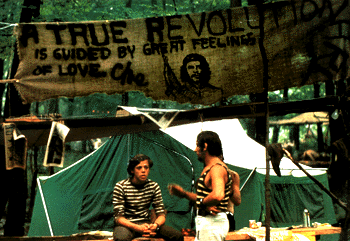INTRODUCTION: 1960'S ROCK I

Because of the limitations of the technology we are using, we have divided 1960's rock into two units, Unit 8, where you are now, and Unit 9. This introduction is for both units.
Rock music in the 1960's was as rich in its variety as it was important in its impact on contemporary society. The big question with 1960's rock is where to start. Following the pattern established years ago with the campus version of the course, which may or may not have some logic to it, we divide the material into the following types:
- Protest music
- Surf Rock
- Motown
- Soul
- British Invasion
- Psychedelic rock
Each of these six types is entirely arbitrary. That means that there are many overlaps and there are bands that don't fit well. For example, the Beatles are clearly British Invasion. Right? But much of their music from Sgt.Peppers has drug overtones so it might fit psychedelic. Some of their music were influenced by Bob Dylan, so it might fit in Folk-rock, which isn't one of our categories. See the problem. All we can say for sure about placing the Beatles is that they are neither Motown nor Soul. So lets just accept the arbitrariness of the categories, try to define them and get on with the music.
1. Protest Music
This grouping in itself is somewhat confusing because it includes several styles of music. The term "protest music" implies the content of the music, not the style. "Protest music" quite simply is music that protests something. There were a lot of "somethings" to protest against in the 1960's, including the treatment of African-American people (the Civil Rights movement), the Vietnam War, the draft, the increasingly authoritarian government, and a number of issues on college campuses. Under protest music, we include Bob Dylan, Arlo Guthrie, Steppenwolf, and Crosby, Stills, Nash and Young.
Two styles lent themselves well to the content of protest music: folk and folk-rock In addition, to some degree Motown and Soul both did involve protest, and for that matter some of the work of the British bands, hard rock bands and the psychedelic rock groups also involved protest.
Folk music is based on American and British music that was passed down through generations by oral tradition. It is a simple, acoustic music about common people and everyday events. Earlier in the 20th century, artists including Woody Guthrie and Pete Seeger began to add new material, which was often political, to the genre, and by the early 1960's, Bob Dylan started the modern era of folk. Of course Dylan is included here as well as Peter, Paul and Mary, Judy Collins, Joan Baez, Arlo Guthrie, Ramblin' Jack Elliott, Joni Mitchell and Country Joe McDonald.
Folk-rock starts with the simple, direct songwriting style of folk music and combines it with a prominent rock backbeat. Folk-rock was first developed by Bob Dylan and played by such 1960's groups as the Byrds, Simon and Garfunkel, Buffalo Springfield, Crosby, Stills, Nash and Young, John Sebastian, The Youngbloods, The Mamas and the Papas and the Turtles.
2. Surf Rock
This was a very popular form of American rock in the 1960s. It was characterized by reverberating guitar work, and massive instrumentals that sometimes sounded like the ocean. In terms of the range of sounds that it explored, it was revolutionary music for its time. Surf groups included the Beach Boys, the Chantays, the Surfaris, Jan & Dean and Ronny & the Daytonas.
3. Motown
Led by Berry Gordy and located in Detroit, Motown developed a sound and style so distinct that the label became known as a genre of music. The Motown sound is easily identifiable -- a strong backbeat supported with bouncy basslines and soulful but very polished vocals. Although a form of R&B, Motown established very high production values and craftsmanship, which gave much of its music a manufactured quality. Among the Motown groups were the Four Tops, Gladys Knight and the Pips, the Supremes, the Temptations, the Marvelettes, Stevie Wonder, and Marvin Gaye.
4. Soul
Soul is an honest, funky type of music that developed in the South based on gospel music and the hard-driving energy of Rhythm & Blues (R&B). Its directness and attention to its R&B roots is direct contrast to the highly polished sound of Motown. Some important soul artists are Otis Redding, Percy Sledge and Aretha Franklin.
This introduction continues in Unit 9 with the British Invasion and Psychedelic Rock.
Go on